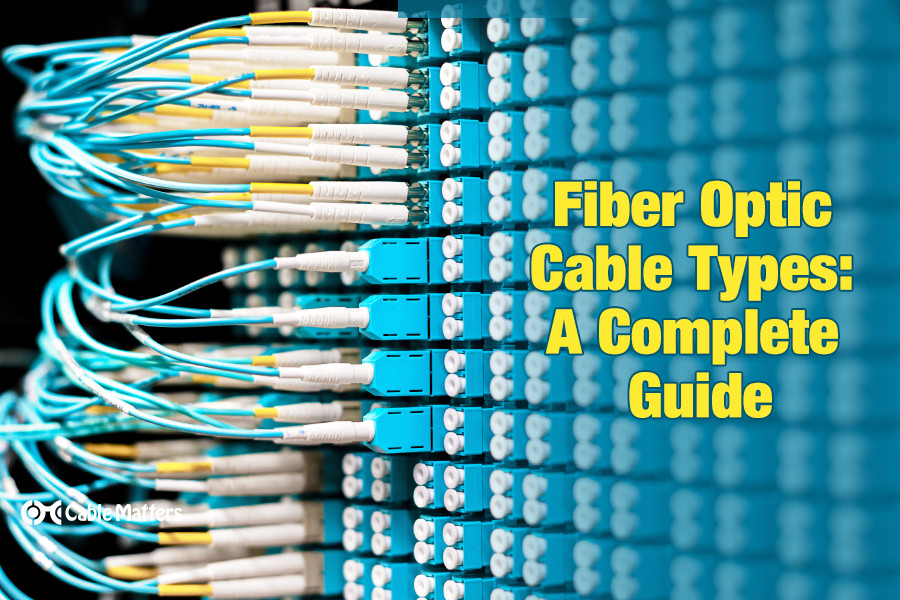
Fiber optic cables are often seen as the gold standard for network cabling. They offer unparalleled performance compared to their typical copper counterparts, and they can therefore cover much greater distances without bumping up against signal degradation, too.
It’s not just the case that fiber optic cables are better, though. There are a wide range of fiber optic cable types, styles, and with different connectors on each end. Depending on what sort of distances you want to cover with your networking wiring and what kind of performance you expect, you might want to opt for one fiber optic cable type over another.
Here’s everything you need to know about the various fiber optic cable types, what makes them so useful, and what type of fiber optic cables you want to buy for your next networking project.
What are Fiber Optic Cables?
Fiber optic cables are, like their name suggests, a cable that uses light, rather than electricity to transmit information. They’re made from silica glass fibers about the same width as a human hair, which allow the light to bounce back and forth down the length of the cabling. To prevent the light leaking out, and ensure it is reflected down the length of the cable, the glass core of a fiber optic cable is surrounded by a thin layer of glass cladding. That is further insulated by a primary coating of plastic which offers physical protection for the internal glass structure of the cable, and prevents excessive bending.
Most high-quality fiber optic cables then further protect the core of the wiring with an extra layer of strengthening fibers which are made of different material, depending on the manufacturer. Some use kevlar, others gel filled sleeves, but most serve the same purpose and have the same end result of reinforcing the cable protection and rigidity.
The final outer layer is a jacket of colored plastic to help identify the fiber optic cable type and provide even greater protection to the interior. Most outer layers also provide a layer of fire resistance for the wiring, with different ratings given to each so buyers can know the level of protection their cabling provides.
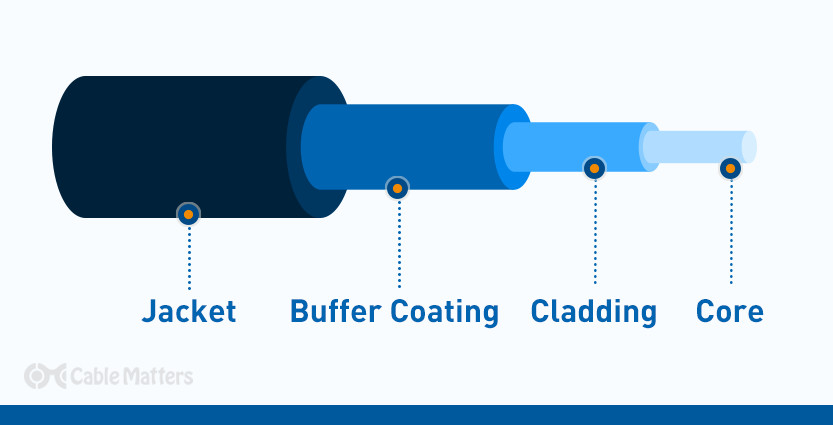
What Does a Fiber Optic Cable Look Like?
Fiber optic cables, from the outside at least, don’t look drastically different from many other kinds of cabling, since their outermost layer tends to be a colored plastic or silicon tubing. It’s common for them to be white, grey, or black in color, but there are more colorful options available if that’s useful. It can sometimes denote a specific feature, too. For example, fiber optic patch cables can have an orange color to denote that its a multimode optical fiber cable, or a yellow jacket to make it clear that it’s a single mode optical fiber cable.
The end of the cable will look different depending on the type of task the fiber optic cable is used for. A TOSLINK optical fiber cable used for audio transmission has a small plastic tip that will show the visible light being transmitted by the cable when plugged in at one end, while a fiber optical patch cable may be fitted with a connector called an LC connector at each end. It can still be visible in some cases, however, and in the case of a laser transmitted light, should not be viewed directly as it can cause severe eye damage.
Single Mode Fiber Optic Cables
Fiber optic cables utilize light to transfer information, so do so at light speed. However, the way the cables are constructed can have a dramatic impact on bandwidth and transmission distance. This isn’t entirely different to the way some other cables, like copper patch cables, or HDMI cables, can have different maximum lengths based on the materials used in their construction, or whether they’re active or passive cables, but fiber optic cabling varies based on a different factor.
Single mode and multimode fiber optic cables are built with different diameters of the core – the glass fibers that transmit the light, and therefore information, down the length of the cable. Single mode fiber cables have a very narrow core, which keeps the path of the light narrow in turn, and results in a cable that can carry the light signal over greater distances before it weakens and needs to be repeated or enhanced.
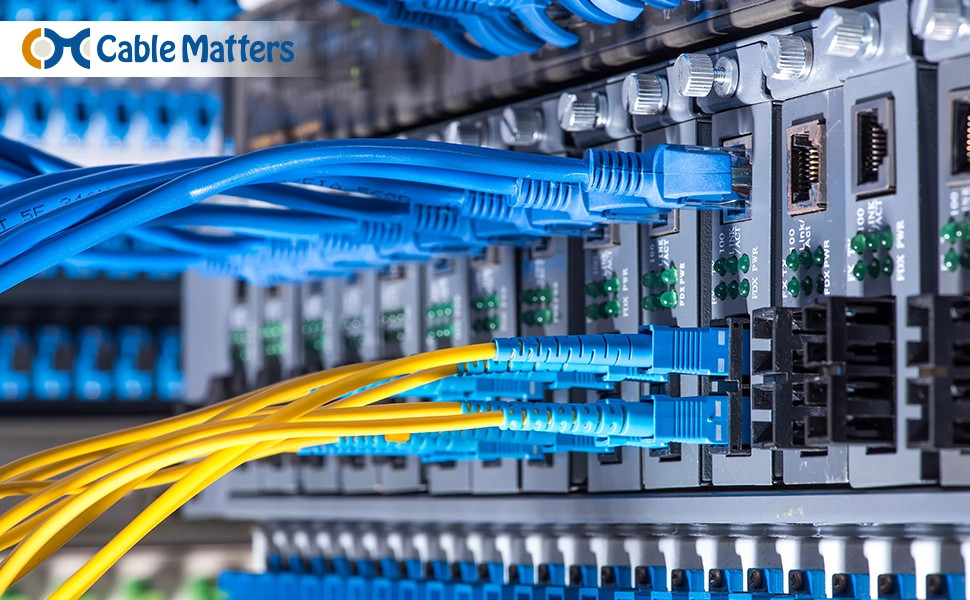
Typically, single mode fiber optic cables are made from a single glass fiber strand, resulting in a very narrow core diameter of around 9µm. This is around six to seven times narrower than a multi-mode fiber optic cable type.
Single mode fiber optic cables can carry a signal over many miles before requiring enhancement. That makes them far more capable for longer-distance data carrying than multi-mode fiber optic cables, which are designed to transmit information over much shorter distances.
The actual maximum distance of a single mode fiber optic cable depends on its transmission rate and cable type. There are two single mode fiber optic cable types: OS1 and OS2. The former is a tight buffered cable that is mostly designed for use in indoor locations where distances tend to be shorter, and electrical interference may be greater. They are typically used over distances no greater than six miles, and support a maximum throughput of 10 Gigabits per second. They tend to be the more affordable of the two cable types.
OS2 cables, on the other hand, are targeted more at outdoor and greater distance use, with a maximum range as great as 125 miles. They also support greater throughput, up to 100 Gigabits per second, and are more expensive than OS1 fiber optic cable types. Outside of their performance potential, OS2 cables are also built in a different manner. They use a loose-tube construction, with the actual fiber optic core laid in a spiral pattern within semi-rigid tubes that allows the cable to stretch and flex without placing any tension on the glass fibers themselves.
OS2 is the fiber optic cable type that provides the best performance over longer distances, and they’re more durable to boot. While they are more expensive, they provide the best connection for grander networks, and are seeing increased usage in all manner of settings thanks to their improved durability and overall throughput support.
It typically sees uses in university campus data networks, cable TV transmission systems, and major telecommunications networks. OS2 cables are often used as backhaul networks too, thanks to their added reliability.
Multimode Fiber Optic Cables
Multimode fiber optic cables are characterized by a much broader internal core, measuring either 50µm or 62.5µm which allows multiple streams of data to be sent down the cable. This allows for the use of more affordable LEDs and vertical-cavity surface-emitting lasers (VCSELs) in their design, which typically makes multimode fiber optic cables much cheaper than their single-mode counterparts.
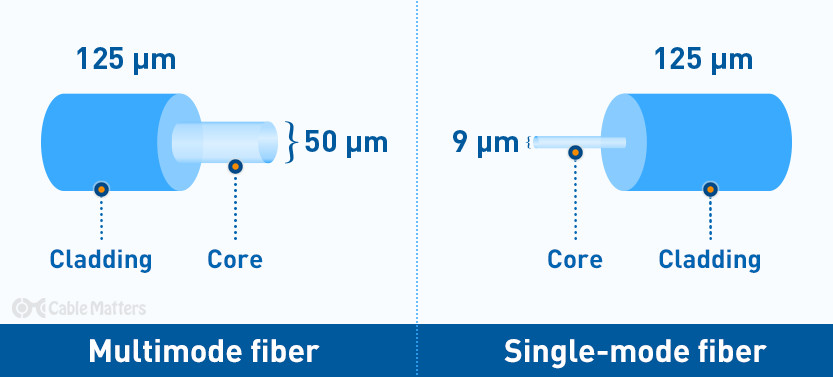
That larger core means that the light reflects off the interior of the core much more frequently, which opens up multiple paths for multiple beams of light to be transmitted simultaneously. However, this does have its limitations, namely greater signal attenuation, which means that multimode fiber optic cables simply cannot support the same distances as single mode cables, and require more regular enhancement if greater distances are required.
Multimode cables are split into five distinct types, with wide-ranging specifications and capabilities. OM1 is the weakest, but most affordable of the fiber optic cable types, with a maximum bandwidth of 10 Gigabits per second at around 100ft. OM2 provides a greater quality connection and can maintain the same performance over 260ft, while OM3 enhances it further to 1000 ft with the same throughput.
OM4 is more impressive, still, and is capable of reaching 1,300 ft at 10 Gigabits per second. That’s much the same for OM5, and both OM4 and OM5 are capable of transmitting a more demanding 40 Gigabits per second and 100 Gigabits per second at up to 500ft. OM5 is the newer standard however, and makes use of short wavelength division multiplexing, which uses different colors of laser light to increase its support for even greater bandwidth, up to 200 Gigabits and even 400 Gigabits per second.
To help differentiate between these different cable types, they each have a different color coding for their outer jacket. OM1 multimode cables usually have orange or grey outer jackets, while OM2 is exclusively orange. OM3 multimode cables utilize a cyan blue coloring, often called aqua, while OM4 cables can use purple or aqua coloring.
The newest, OM5 cable type, use a lime green coating to highlight its distinct design profile.
Although it is possible to mix and match OM2, OM3, OM4, and OM5 cables, it’s not advisable, due to their different performance capabilities. It is physically impossible to mix and match OM1 with any other of the fiber optic cable types, however, due to their different size core.
Single-mode and multi-mode fiber optic cable types aren’t interchangeable either, due to the difference in core diameter and their differing light wavelengths.
Which Fiber Optic Cable To Buy
Cable Matters produces a wide range of single mode and multi-mode fiber optic cable types, supporting a range of sizes/distances, and performance targets.
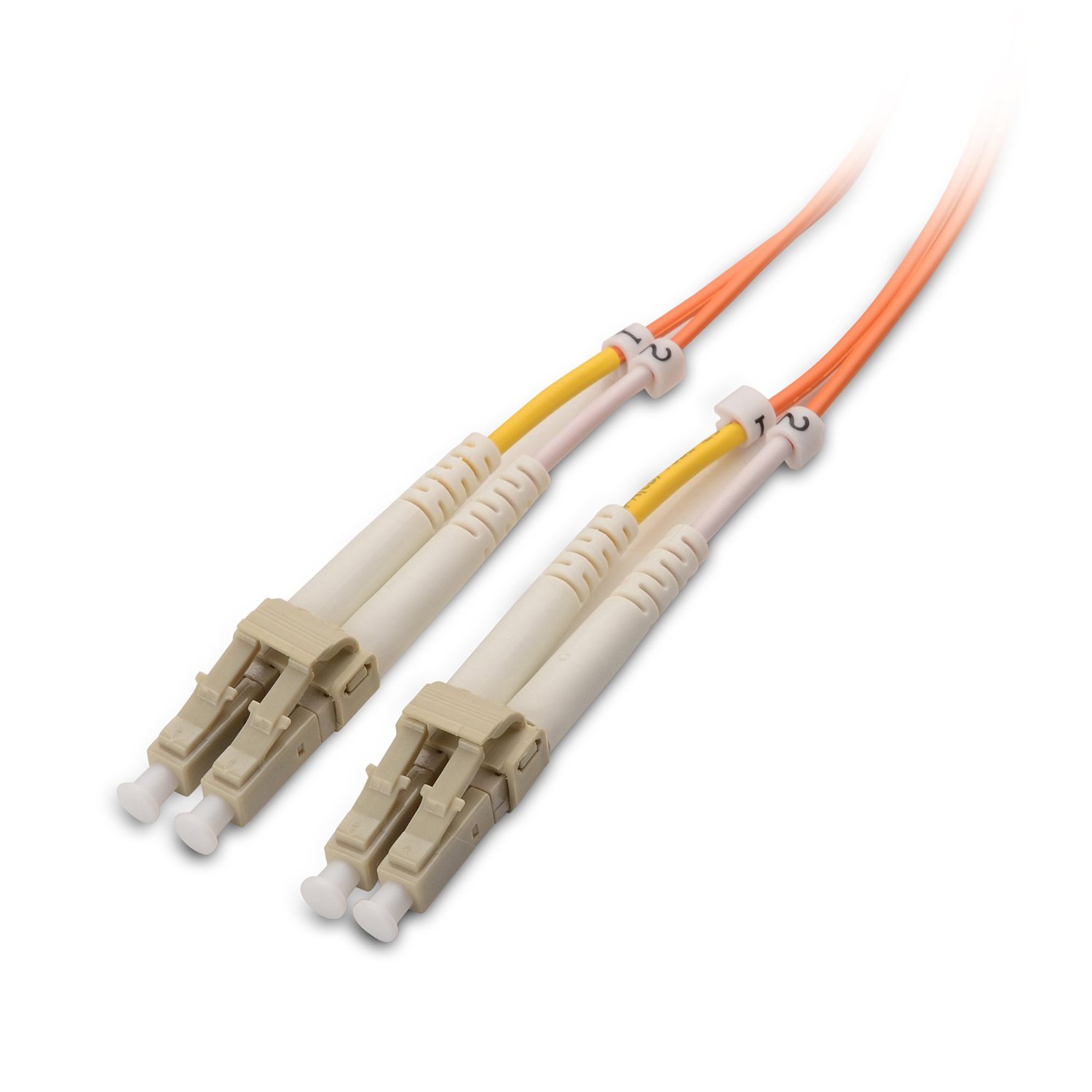
If you’re looking to expand a legacy fiber optic connection, or only need a very short, low-performance fiber optic cable, Cable Matters' OM1 multimode fiber optic cable is available at a low price and with options of 3.3ft, through to 10ft, depending on your needs. Even though it’s an entry-level, affordable cable, though, it still is made to a high standard, with slim profile boots that provide excellent strain relief and the LC connectors sit in a protective yoke to prevent damage that can occur during frequent unplugging. It’s also built with a duplex zipcord design for sturdy construction, and enjoys a plenum jacket fire safety rating that meets UL 910 requirements.
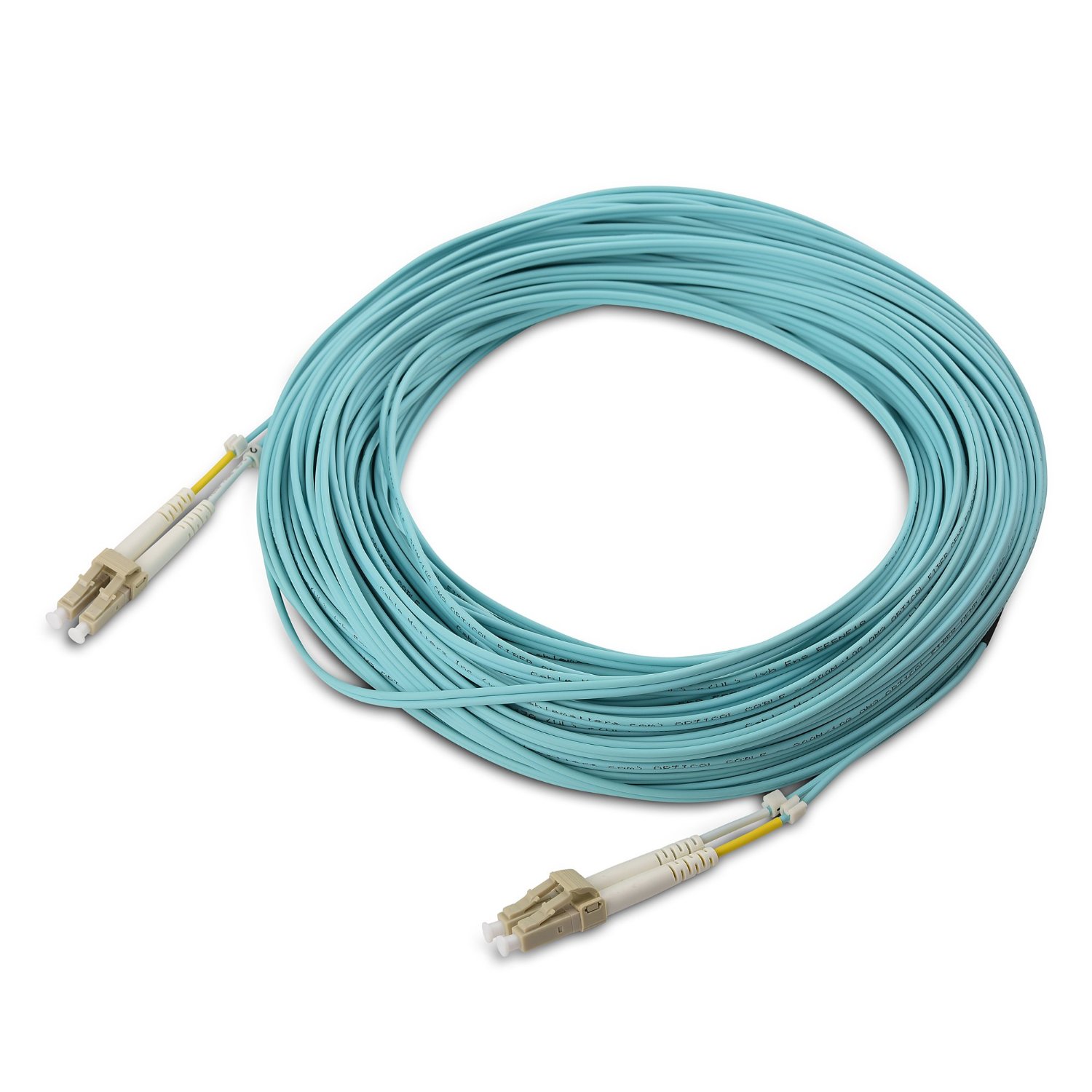
If you need a more capable connection, Cable Matters also offers OM3 fibre optic cables that are available in a much greater range of lengths. You can still use them for super short runs as limited as three feet, or you can use them to cover much greater distances up to 164ft. Whichever option you choose, you’ll get the same high quality cable made with bend insensitive fiber that provides excellent flexibility for tight spaces and sharp corners. They also come with slim profile strain relief boots for improved durability and flexibility, and every cable comes with removable dust caps which prevent dirt and debris from affecting the fiber – and they protect your eyes during installation.
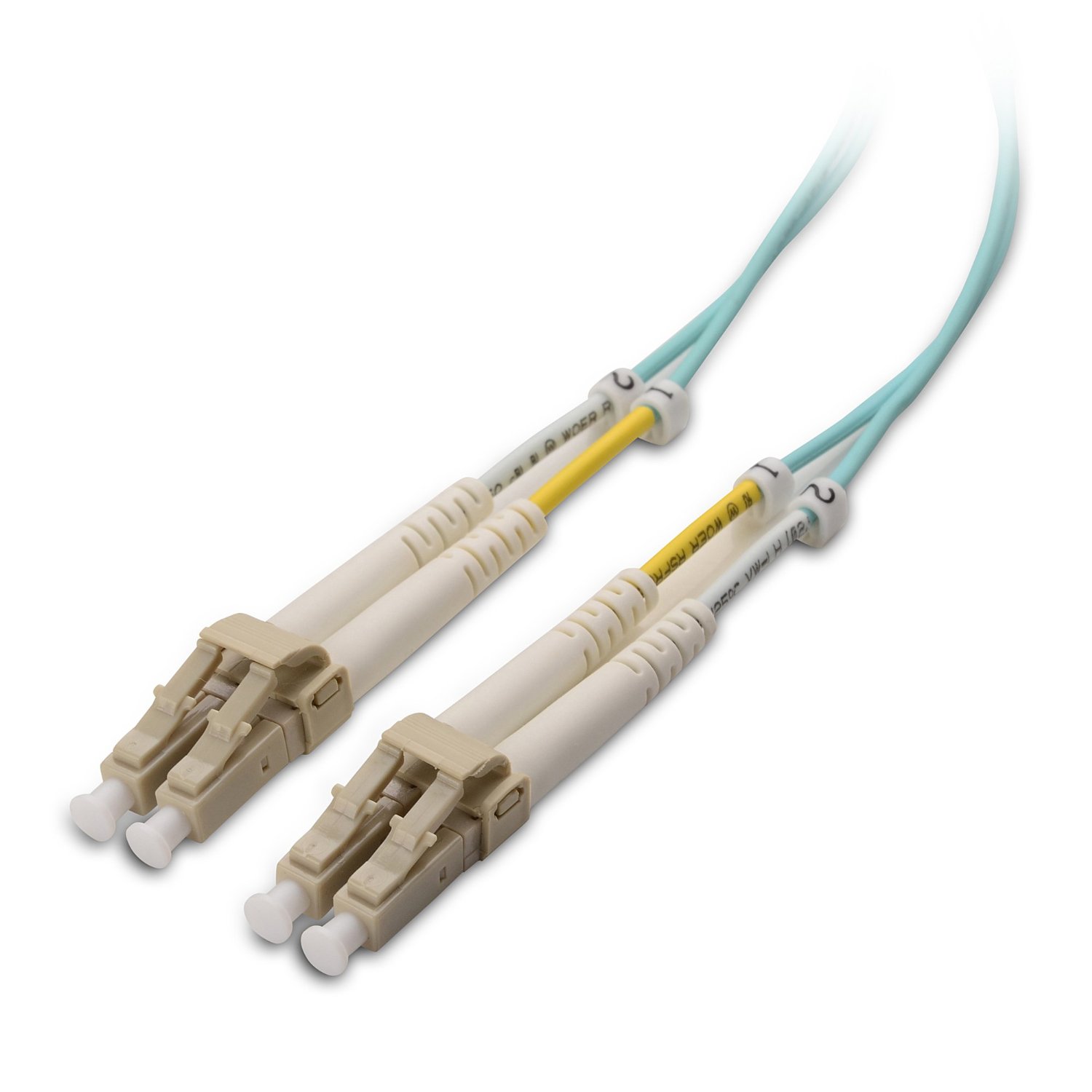
OM4 cables are also available in our store, ranging in size up to 100ft. These cables offer much greater support for higher bandwidth gigabit connections and are excellent for storage area networks, data centers, and more intense networking environments. Their laser optimized multimode fiber designs ensure that you get the maximum performance without undue signal attenuation over their length, and the bend insensitive design makes them far more flexible than standard fiber optic cable types.
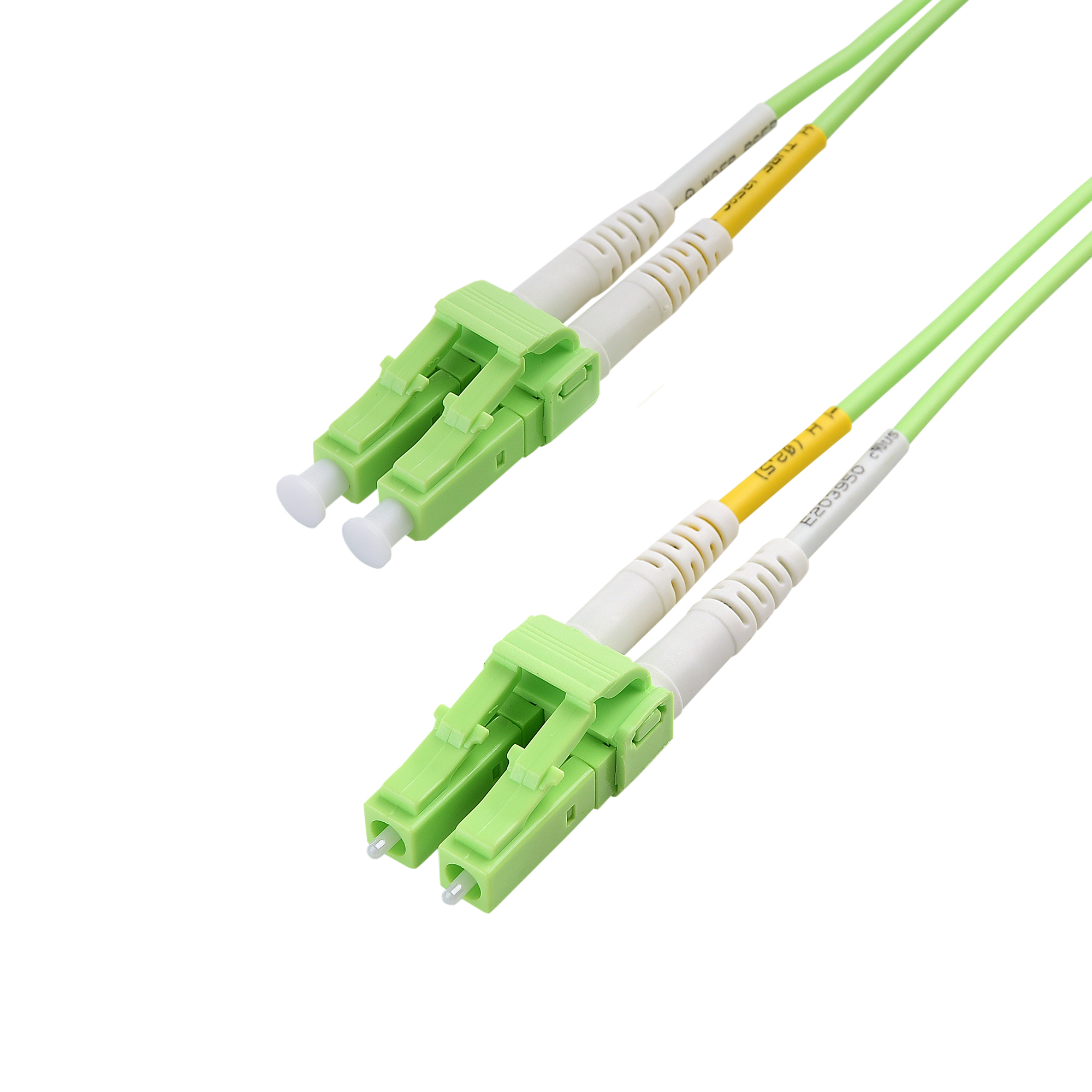
For the absolute latest in multimode fiber optic cable performance, the new OM5 standard is also available in a range of lengths and targets the most high-performance of network infrastructure. If you want to run a network at 200 or 400 Gigabits per second, a Cable Matters OM5 multimode cable will do the job well. They’re plenum rated and meet all 910 regulations, provide excellent fire resistance in the event of a catastrophe, and they’re fully backwards compatible with existing OM3 and OM4 cabling, so are a great way to begin a network upgrade without having to overhaul the entire thing in one go.
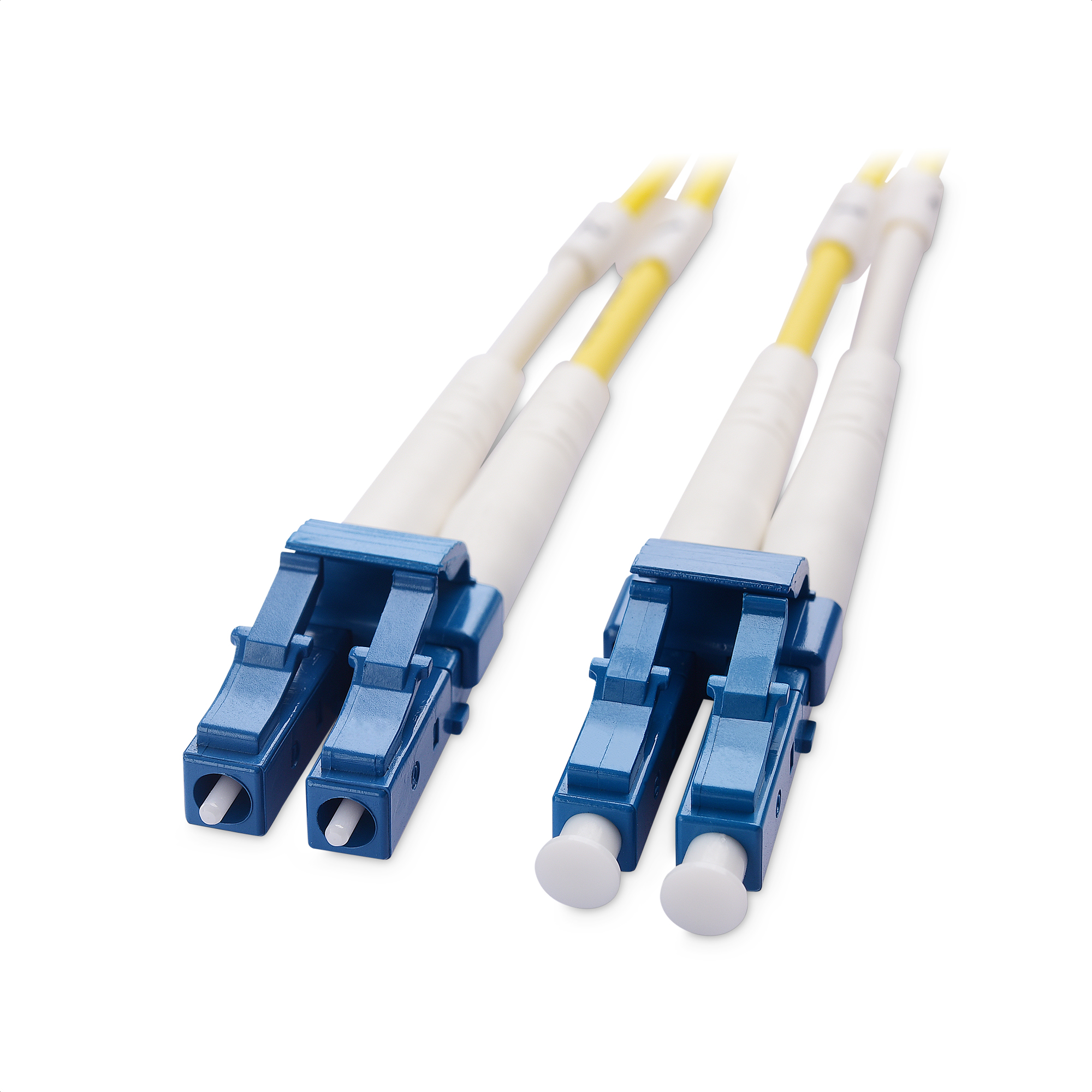
For more sensitive applications, consider the cable matters OS2 single mode fiber optic cable, which supports cable distances of up to six miles on a 10 Gigabit per second connection, and is backwards compatible with existing OS1 fiber optic cables. Like all Cable Matters fiber optic cables, the OS2 cable has slim profile strain resistance boots, and is built to a superior standard to ensure impressive durability, no matter the environment you run the cable in.
If you’re looking to build your own fiber optic cables and patch panels, Cable Matters can also supply keystone coupler jacks that support a range of multimode fiber optic cable types, as well as OS2 single mode cables. They feature stainless steel retention clips and enjoy a sturdy snap-in construction to make cable connection quick and easy, without impacting durability.
Lastly, Cable Matters also offers an affordable line of fiber optic transceivers. These devices convert SFP fiber connectors common on enterprise-grade routers and switches to the LC connectors of fiber optic cables.